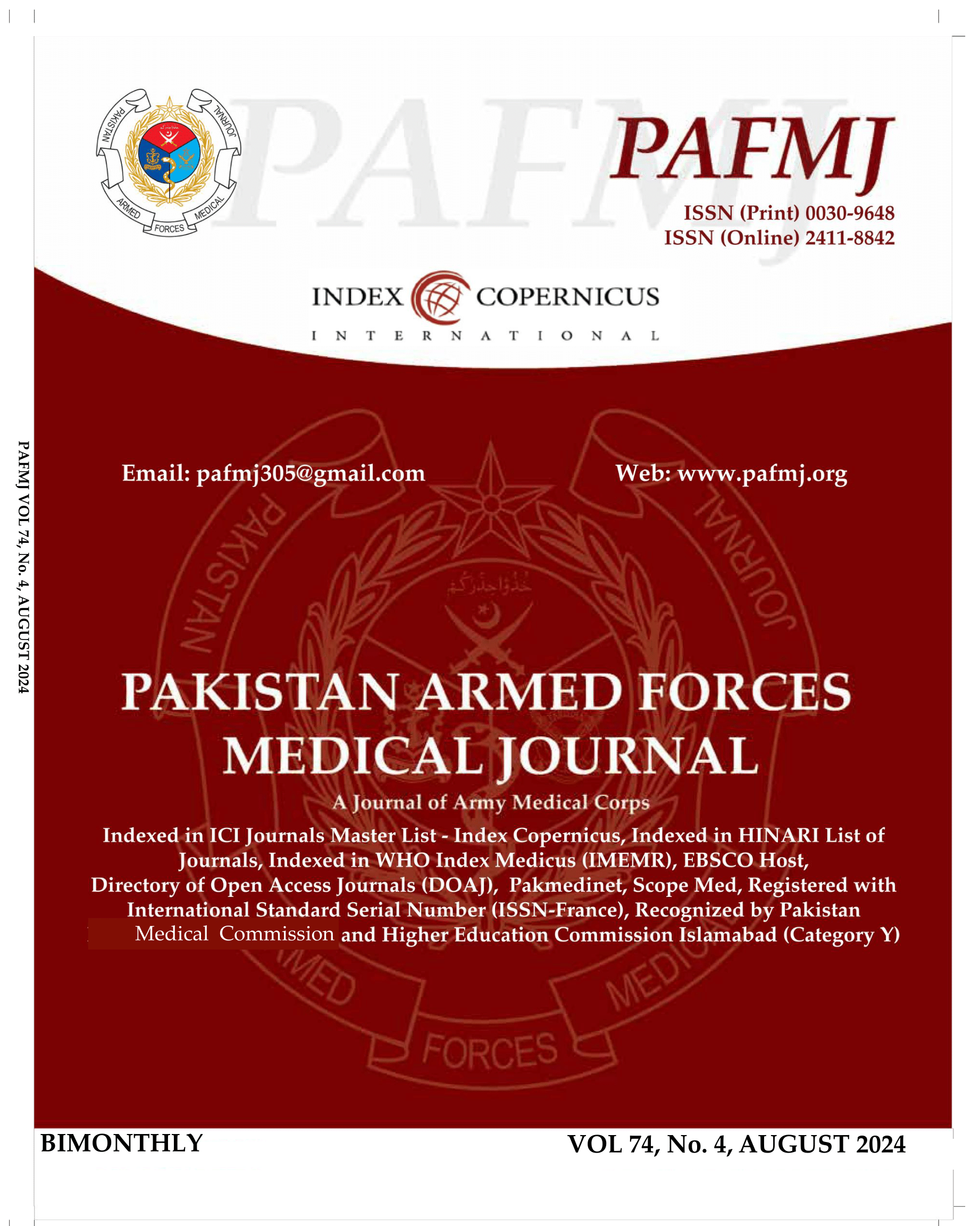Frequency of Diplopia and its Management in Patients with Midfacial Fractures at A Tertiary Institute of Dentistry
DOI:
https://doi.org/10.51253/pafmj.v74i4.3242Keywords:
Closed reduction, Diplopia, Midfacial bone fractures, Open reduction and fixation.Abstract
Objective: To determine the frequency of diplopia and its various management options in midfacial fractures.
Study Design: Cross-sectional study.
Place and Duration of Study: Armed Forces Institute of Dentistry, Rawalpindi Pakistan, from Apr 2017 to Apr 2019.
Methodology: All patients who presented with midfacial fractures were included in the study. Patients were categorized into 6 age-groups. All patients underwent CT scan of the skull and a forced duction test was performed. Patients with a positive forced duction test underwent early repair surgically either with open reduction and internal fixation or closed reduction. Conversely, patients who had a negative forced duction test were treated conservatively if there was no other indication for early surgical repair.
Results: Out of 80 patients, 69(86.3%) were males. Diplopia was present in 16(20%) patients and forced duction test was positive in 9(56.25%). Sixty-five (81.3%) patients were managed surgically and 15(18.8%) conservatively. Resolution of diplopia was also significantly associated with early surgical intervention (p<0.01). One patient who presented after 3 weeks of injury did not have any resolution of diplopia even after 3 weeks of surgery.
Conclusion: Diplopia was commonly found in midfacial fractures due to trauma. Early presentation and surgical intervention were associated with better outcomes.
Downloads
References
Jose A, Nagori SA, Agarwal B, Bhutia O, Roychoudhury A. Management of maxillofacial trauma in emergency: An update of challenges and controversies. J Emerg Trauma Shock 2016; 9(2): 73. https://doi.org/10.4103/0974-2700.179441
Norozy A, Motamedi MH, Ebrahimi A, Khoshmohabat H. Maxillofacial fracture patterns in military casualties. J Oral Maxillofac Surg 2019; 78(4): 611.
https://doi.org/10.1016/j.joms.2019.06.005
Rajkumar GC, Ashwin DP, Singh R, Prashanth R, Rudresh KB. Ocular injuries associated with midface fractures: A 5-year survey. J Maxillofac Oral Surg 2015; 14(4): 925-929.
https://doi.org/10.1007/s12663-015-0805-1
Zachariades N, Papavassiliou D, Christopoulos P. Blindness after facial trauma. Oral Surg Oral Med Oral Pathol Oral Radiol Endod 1996; 81(1): 34-37.
https://doi.org/10.1016/S1079-2104(96)80141-0
Runci M, De Ponte FS, Falzea R, Bramanti E, Lauritano F, Cervino G, et al. Facial and orbital fractures: A fifteen-year retrospective evaluation of Northeast Sicily treated patients. Open Dent J 2017; 11:546.
https://doi.org/10.2174/1874210601711010546
Becker ST, Terheyden H, Fabel M, Kandzia C, Möller B, Wiltfang J. Comparison of collagen membranes and polydioxanone for reconstruction of the orbital floor after fractures. J Craniofac Surg 2010; 21(4): 1066-1068.
https://doi.org/10.1097/SCS.0b013e3181e1f3a8
Elarabi MS, Bataineh AB. Changing pattern and etiology of maxillofacial fractures during the civil uprising in Western Libya. Med Oral Patol Oral Cir Bucal 2018; 23(2): e248. https://doi.org/10.4317/medoral.22258
Zaleckas L, Pečiulienė V, Gendvilienė I, Pūrienė A, Rimkuvienė J. Prevalence and etiology of midfacial fractures: A study of 799 cases. Medicina 2015; 51(4): 222-227.
https://doi.org/10.1016/j.medici.2015.04.005
Tong L, Bauer RJ, Buchman SR. A current 10-year retrospective survey of 199 surgically treated orbital floor fractures in a
nonurban tertiary care center. Plast Reconstr Surg 2001; 108(3): 612-621.
https://doi.org/10.1097/00006534-200109000-00006
Folkestad L, Westin T. Long-term sequelae after surgery for orbital floor fractures. Otolaryngol Head Neck Surg 1999; 120(6): 914-921.
https://doi.org/10.1016/S0194-5998(99)70331-5
Wang S, Xiao J, Liu L, Lin Y, Li X, Tang W, et al. Orbital floor reconstruction: a retrospective study of 21 cases. Oral Surg Oral Med Oral Pathol Oral Radiol Endod 2008; 106(3): 324-330.
https://doi.org/10.1016/j.tripleo.2007.09.013
Burnstine MA. Clinical recommendations for repair of isolated
orbital floor fractures: An evidence-based analysis.
Ophthalmology 2002 Jul 1; 109(7): 1207-1210.
https://doi.org/10.1016/S0161-6420(02)01056-5
Maus M. Update on orbital trauma. Curr Opin Ophthalmol 2001; 12(5): 329-334.
https://doi.org/10.1097/00055735-200110000-00011
Clavero MA, Sanz MV, Til AM, Ferrer ÚM. Factors influencing postsurgical diplopia in orbital floor fractures and prevalence of other complications in a series of cases. J Oral Maxillofac Surg 2018; 76(8): 1725-1733.
https://doi.org/10.1016/j.joms.2018.03.023
Putterman AM. Management of blow-out fractures of the orbital floor: III. The conservative approach. Surv Ophthalmol 1991 Jan 1; 35(4): 292-298.
https://doi.org/10.1016/0039-6257(91)90140-T
Yu DY, Chen CH, Tsay PK, Leow AM, Pan CH, Chen CT. Surgical timing and fracture type on the outcome of diplopia after orbital fracture repair. Ann Plast Surg 2016; 76: S91-95.
https://doi.org/10.1097/SAP.0000000000000570
Manson PN, Iliff N. Management of blow-out fractures of the orbital floor: II. Early repair for selected injuries. Surv Ophthalmol 1991; 35(4): 280-292.
https://doi.org/10.1016/0039-6257(91)90139-M
Bartoli D, Fadda MT, Battisti A, Cassoni A, Pagnoni M, Riccardi E, et al. Retrospective analysis of 301 patients with orbital floor fracture. J Cranio-Maxillofac Surg 2015; 43(2): 244-247.
https://doi.org/10.1016/j.jcms.2014.12.001
Haider AK, Hameed H. Evaluation of ocular injuries associated with midfacial trauma. Pak Oral Dent J 2018;38(1):38-41.
Samieirad S, Aboutorabzade MR, Tohidi E, Shaban B, Khalife H, Hashemipour MA, et al. Maxillofacial fracture epidemiology and treatment plans in the Northeast of Iran: A retrospective study. Med Oral Patol Oral Cir Bucal 2017; 22(5): e616.
https://doi.org/10.4317/medoral.21962
Erol B, Tanrikulu R, Görgün B. Maxillofacial fractures. Analysis of demographic distribution and treatment in 2901 patients (25-year experience). J CranioMaxillofac Surg 2004; 32(5): 308-313.
https://doi.org/10.1016/j.jcms.2004.04.006
AlGhadouni M, AlOtaibi Y, ElTahir M, Alanezi M. Prevalence, patterns and etiology of maxillofacial fractures in Qassim Province, Saudi Arabia. Saudi Dent J 2019; 31: S15. https://doi.org/10.1016/j.sdentj.2019.01.004
Barry C, Coyle M, Idrees Z, Dwyer MH, Kearns G. Ocular findings in patients with orbitozygomatic complex fractures: a retrospective study. J Oral Maxillofac Surg 2008; 66(5): 888-892.
https://doi.org/10.1016/j.joms.2007.07.035
Ravindran V, Nair KR. Meta-analysis of maxillofacial trauma in the northern districts of Kerala: one-year prospective study. J Maxillofac Oral Surg 2011; 10(4): 321-327.
Downloads
Published
Issue
Section
License
Copyright (c) 2024 Wajid Meraj, Irfan Shah, Adnan Babar, Saad Mehmood, Kaleem Niazi, Humaira Sarwar

This work is licensed under a Creative Commons Attribution-NonCommercial 4.0 International License.















